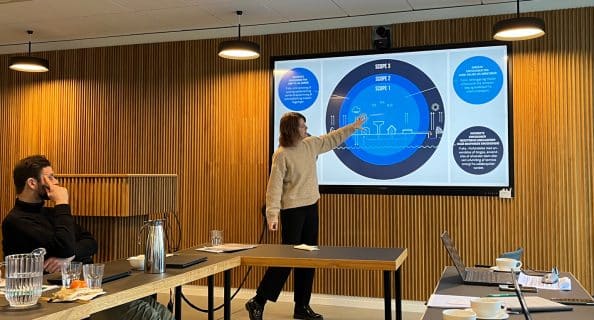The water sector wants to contribute to the Danish government’s ambition from the “Action Plan for Circular Economy” by reaching climate neutrality by 2030.
To achieve this, the sector needs to take SDG 17, Partnerships for Action, seriously and work together to reduce the sector’s climate impact – not just the impact of operations, but also the impact of construction activities.
There is no other way around it. The Danish water sector is not on target when it comes to climate neutrality. As a sector, we use a lot of energy when pumping both clean and filthy water from one place to another. We use consumables in our operations, which also have an environmental and climate footprint, and when we build facilities, whether it is pipelines, construction works, waterworks or treatment plants, there is a large consumption of materials such as steel and concrete, which also have a considerable climate footprint: Construction works complicate CO2 neutrality in the water sector (article in Danish)
With that said, over the last several years, the sector has taken a big step towards more environmental sustainability. We have managed to work on our operational activities in many places. At some of the larger treatment plants, we have managed to optimize the plants so they produce more energy than they consume – and they have thus become resource plants. We have plants where solar cells are built into the plant itself to produce green energy, and over time, the climate impact from the production of electricity will gradually be reduced as renewable energy is rolled out in Denmark.
We cannot build our way to sustainability
But what about our construction projects? As it is today, the sector is well on its way in terms of operations. Individual analyses indicate that annual CO2 emissions from construction activities are up to 10 times higher than those from operations. However, we currently lack a comprehensive overview that shows how much of a climate footprint we actually contribute with as regards to construction. An overview of that is the first step towards acting differently in our choice of activities and materials.
We have the smallest impact on the climate if we don’t build at all. However, we do have some societal challenges that need to be addressed. This includes pollutants in our drinking water, which requires treatment and the implementation of new technologies. In addition, climate challenges such as flooding due to extreme rainfall require investment in green surface projects and in underground infrastructure such as pipes and basins, as well as more treatment capacity at our wastewater treatment plants. The conclusion is therefore that we cannot stop building, but we can postpone renewal where possible and build smarter, taking into account the environment and the climate.
As mentioned above, the sector has come a long way by focusing on operations, and this makes perfect sense. But now, it is necessary to focus on our construction activities as well. Real knowledge on the impact of our construction activities allows us to use materials and construction methods that are sustainable. Knowledge should allow us to change norms and standards in the sector, so we can also make conscious sustainable choices within construction activities.
A new common tool for sustainability in the water sector
As a sector, looking ahead and incorporating environmental sustainability into our decisions and activities, we need to find a common language. This language should be based on a Life Cycle Assessment (LCA), focusing on the operation and construction phases as well as the disposal/recycling of our individual assets. We won’t achieve the objective if all possible methods are taken into use, resulting in different results. We need to use the same parameters and thus move the sector in the same direction. The first step is to develop an industry standard for LCA to help shed light on our activities across the value chain. This allows us to focus on the main challenges.
At Envidan, we have set ourselves the specific goal of being able to advise all our customers in terms of environmental sustainability within the planetary boundaries. This means that we help our clients define, whether their activities are within the limits of what our planet can handle. We already have some of the country’s brightest minds within sustainability that we can bring into play when helping our customers, and we want to be frontrunners in bringing the sector together to develop an industry standard regarding LCA.
Water sector law hinders reduction of our climate footprint
If we are to reach our goal of a climate neutral water sector by 2030, we need to keep in mind that the climate neutral option is not necessarily the most economically beneficial option. To achieve the target, we will therefore need to look at a reassessment of the Danish Water Sector Act.
As for now, the Water Sector Act is structured in such a way that there are high efficiency requirements for utilities on existing and new activities and assets, pushing utilities to choose the cheapest alternatives and perhaps not to include climate neutrality or sustainability in their decision-making.
We need future regulation that allows utilities to work with multiple bottom lines – economic, environmental and social. In this way, we can jointly move the water sector in the right direction, where we can solve the tasks of the water sector and at the same time operate within the planetary boundaries.
Cooperation is sustainable
The UN Sustainable Development Goal 17 on partnerships emphasizes this once again. We cannot transform the water sector and achieve our common goals if we do not all contribute and find common solutions. Within the sector, we ought to shift our focus from seeing sustainability as a battle arena, where consultants fight to have the right tool for the sustainability calculations, to instead seeing sustainability as a way of entering into new and long-term partnerships where sustainable solutions are in focus. Everyone in the sector needs to contribute if we want to achieve our climate goals and contribute positively to the sectoral objective of climate neutrality by 2030.
Internally in Envidan, we took an important step in our sustainability work when we placed sustainability at the management level. Mads Uggerby was appointed as Director of Innovation & Sustainability, and together with his team, we are working hard to ensure that we both internally in the company and externally with our customers and partners make a positive difference for the sustainability agenda and thus contribute to creating a more sustainable future.
We have therefore shifted our strategic focus on sustainability, so that we no longer have a separate sustainability strategy. Sustainability is now the foundation of our business strategy.
For actors in the water sector, the first step on the journey is to integrate sustainability into the core of the business. Then, we can build partnerships and work together to achieve synergies within the sector and create links to other sectors across industries.




